|
GETAC B300 ultra-rugged notebook computer
Once again upgraded to the latest performance and communications levels, Getac's B300 aims to be fastest, most secure, and toughest ultra-rugged notebook in its class
(by Conrad H. Blickenstorfer -- photography by Carol Cotton -- also see Getac B300 summary review)
Share on:




There are times when nothing but a full size, full function, tough and rugged notebook computer will do, and preferably one that isn't being restyled and redesigned every other year, because that needlessly obsoletes customer investment and equipment. The Getac B300 is one of those, one of the very few, and it's now in its sixth generation. The B300 was introduced almost a decade ago to fill the need for a compact, fully rugged notebook computer with long battery life and a display bright enough to be read in full sunlight. It was that then, and it is that now.
For this latest generation, Getac significantly beefed up security by combining several layers of hardware and software protection technology to guard against breaches and unauthorized access to sensitive information. The newly enhanced B300 also benefits from Intel 6th generation ("Skylake") i5 and i7 processors, boosting graphics performance and efficiency over the previous generation of the platform. This and additional upgrades and improvements in wireless communication and components keep the B300 at the technological forefront in the ultra-rugged notebook market, and well equipped to serve even under the most extreme working conditions.
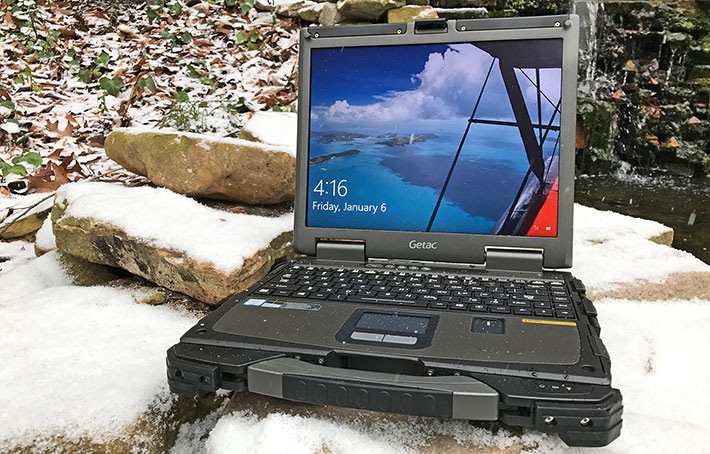
Sporting its trademark industrial design and good ergonomics, the 13.3-inch Getac 300, made almost entirely of tough magnesium alloy, remains an impressive overall performer that now combines state-of-the-art processing power with contemporary multi-level security and exceptionally long battery life (up to 30 hours with two batteries).
Getac B300 positioning
When it comes to building mobile computers that can stand up to more abuse than standard consumer equipment, there are several ways to go. If cost is no object you can build a fortress of a laptop designed to survive the most severe conditions imaginable. If cost is an object, you may go with a toughened-up version of a consumer product. The sweet spot, however, is somewhere between extreme and semi-rugged — machines that offer all the features and performance of a standard consumer notebook computer, yet are able to absorb the kind of abuse they may encounter on tough jobs in the field, in vehicles, and even on the frontline. And as if meeting those requirements were not difficult enough already, the machines must also be reasonably compact and not too heavy. And their batteries must last longer since there are few power outlets in the field.
The market for standard-size rugged notebook computers is led by Panasonic, Getac, and Dell. There are other contenders, such as GammaTech and Amrel (now MilDef), and there are some Taiwan-based OEMs selling ruggedized notebooks under third party brands. But it's probably fair to say that Panasonic and Dell are Getac's major competitive targets. 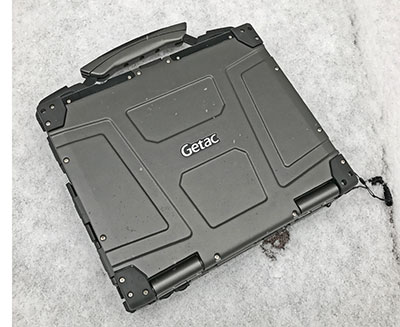 And of these, Getac's longtime nemesis has been Panasonic. And of these, Getac's longtime nemesis has been Panasonic.
Panasonic's Toughbook CF31 and Getac's B300 are the Ali and Frazier, or Frazier and Ali, of rugged notebooks, evenly matched heavyweight fighters where one might be ahead and then the other.
In terms of dimensions, weight and display size, rugged notebooks in this class are — measured by tablet and flimsy Chromebook standards — behemoths indeed. They weigh eight pounds or more. The B300's beefy battery alone weighs more than an iPad Air2. Displays measure 13.3-inches diagonal, in the old 4:3 aspect ratio that makes the screens look tall and squarish by modern standards.
The B300 has a footprint of 11.9 x 10.3 inches, and the substantial magnesium handle with a group of indicator lights in its base adds another inch and a quarter. Our latest review machine weighed in at 8.75 pounds, including handle and battery. The B300 is also about 2.4 inches thick, so this is a substantial piece of equipment by any standard. Size and weight, however, are about average in this class. Computers like the B300 aren't designed to slip into a briefcase.
What's expected from such a machine? Enough performance to run almost any application well. A display bright enough to be used out in the sun. A multimedia bay for an optical drive or a second battery or hard drive. Covering all the bases in wireless communication, and enough onboard connectivity to hook up to almost anything. There must also be a full-size keyboard, sealing good enough to handle dust and rain, enough ruggedness to survive a drop and getting bumped around in a vehicle, and a warranty that lets you sleep at night. The Getac B300 delivers in all these areas. And with the latest electronics upgrades under the hood, it's technologically up-to-date.
Design and construction
The magnesium-alloy housing of the Getac Getac B300 with its matte black and gun-metal gray color scheme is timeless, elegant and tough. It combines pleasing industrial design with a lot of mechanical-looking details that give the computer a purposeful no-nonsense look. The visual message is that the B300, while quite attractive, is a tool for tough jobs. And a product that wants to eat the Panasonic Toughbooks' lunch. Below you can see the unit from the top and all four sides:
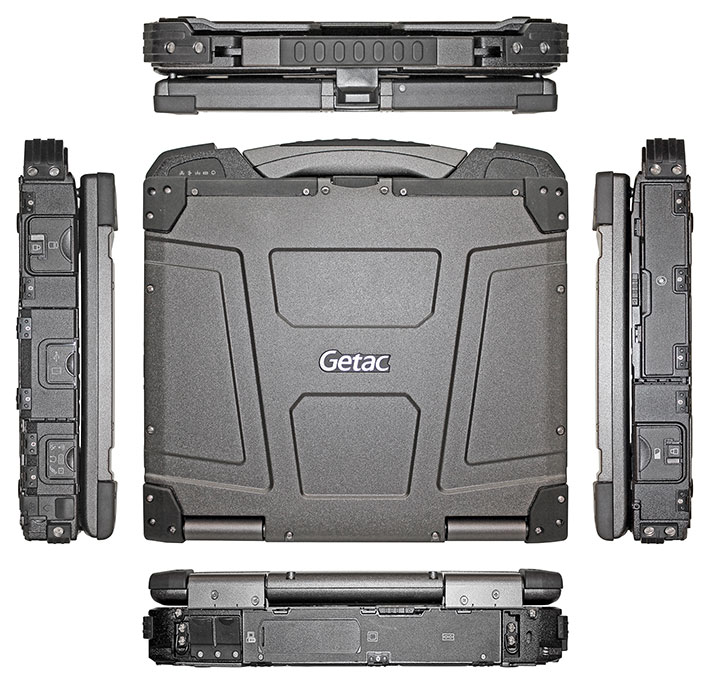
When they originally designed this fanless machine back a decade ago, Getac engineers faced the challenge of dissipating the heat of a powerful processor. They did this by using a total of almost three feet of copper heatpiping that removed the heat generated by the primary chips.
Amazingly, despite switching to ever more powerful CPUs with much higher thermal design power (37 watts in Gen 5 versus just 17 watts originally), Getac managed to stay with a fanless design. How they did it becomes obvious once you remove the inside of the bottom cover. It uses the same thermal engineering principles as used in the original B300: heat spreader plates press against the CPU and chipset via thermally conductive material, the heat spreader plates connect to copper heat pipes, and the copper heat pipes are secured to the Magnesium alloy backplate. While the overall thermal design method remains the same, heat is spread (and dissipated) much more efficiently by substantially expanding copper heat piping over the years and generations. Outside, a sheet of thin, hard plastic is glued onto the surface, either to provide additional protection against scratching, or to make for a cooler touch when held in your hands.
Below you can see the original B300's thermal design solution (left), and the significantly beefed-up solution of the current 6th generation B300 (right). It's the same that allowed operating a 37-watt Core i7 processor in the 5th generation model in 2013. Given that the new Gen 6 model uses much cooler running processors, there is now a substantial thermal cooling safety margin (our test unit barely heated up). And running cooler means the system won't throttle performance due to hitting thermal limits nearly as often.
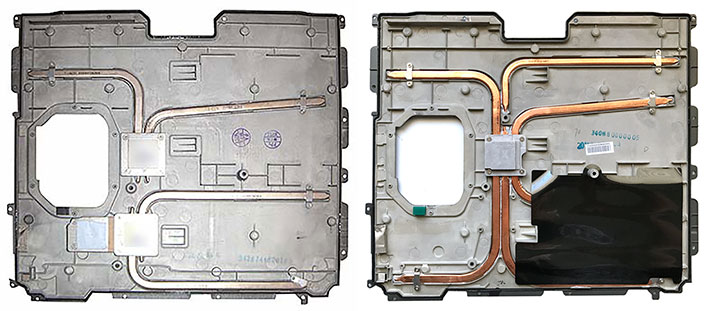
The bottom of the unit consists of a contoured magnesium alloy plate with a continuous O-right style seal along the entire perimeter. It is held securely in place by 18 small Philips screws (they still come in different sizes; standardizing would be better). The whole assembly has an industrial high-tech look that always differentiates Getac machines.
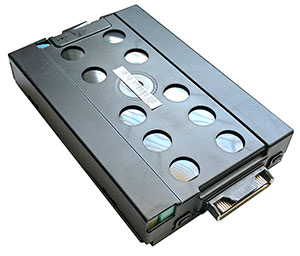 The sole door in the bottom plate has eight rounded corner — no mere rectangles here — and is also neatly and precisely sealed via foam pressing against an o-ring-style metal lip. The door is secured with six small Philips screws and provides access to the unit's two SO-DIMM slots (in our unit populated with two 2GB DDR4 2133 SDRAM modules). The sole door in the bottom plate has eight rounded corner — no mere rectangles here — and is also neatly and precisely sealed via foam pressing against an o-ring-style metal lip. The door is secured with six small Philips screws and provides access to the unit's two SO-DIMM slots (in our unit populated with two 2GB DDR4 2133 SDRAM modules).
The hard disk caddy (see image to the right) is a remarkably intricate affair consisting of a metal outer housing heavily padded with different types of foam and neoprene. The optical drive in our unit was a Sony Optiarc AD-7717H DVD/CD rewritable drive.
The battery is a powerful 11.1 Volt/8,700mAH 96 watt-hour unit with a built-in battery gauge that shows charge status via five green lights upon pressing the button next to it. You can't see the charge meter when the battery is installed in the unit, but it comes in handy when you carry spare batteries around. The battery can be removed if the unit is plugged in, but it is not hot-swappable.
The image below shows the inside of the Getac B300. Getting inside for service or maintenance is easy: just undo those small Philips screws and the bottom plate comes right off. There is no need for an internal frame or chassis here; the vault-like housing of the B300 is the frame and chassis.
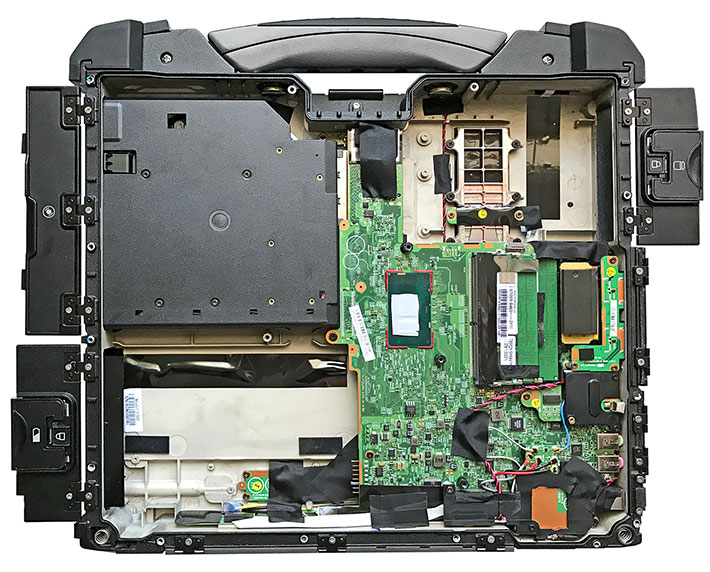
As a full-size rugged notebook, the B300 comes with a full complement of ports, all of which are protected either by rubber plugs or hinged doors. The pictures below right show the left and the right side of the B300, both with the doors open and closed.
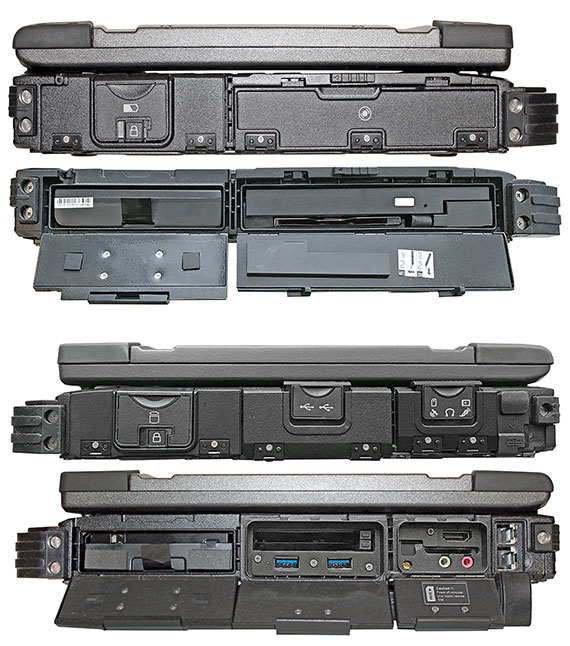
On the left side of the unit are the Media Bay and access to the main battery. The Media Bay is protected by a hinged door that snaps closed when two hooks engage. A spring-loaded lever releases the hooks. The door seals tightly when closed. The battery compartment has a double-locking mechanism. First you move a small lever to unlock the main lever. Then you move a larger lever to fully release the door. Both levers go hard and it is unlikely that they'll ever open by accident. Our review unit also came with a Smart Card reader underneath the optical drive.
On the right side you find access to the hard disk (well, solid state disk these days), expansion ports, and a variety of other ports. The hard disk caddy sits behind a double-lock door like the one used for the battery on the other side. The door closes and seals securely, but it cannot be locked, and thus provides potentially unwanted access to the hard disk. On the other hand, military and other customers often require the ability to quickly and easily remove the hard disk. A hinged plastic door with a rubber pressure seal protects the stacked PC Card Type II and ExpressCard 34/54 slots and two USB 3.0 ports. A compartment next to it has separate microphone and headphone jacks, a spare cutout for an optional GPS antenna, an HDMI port, a springloaded SD card slot, an optional SIM card slot, and an (unmarked) RF switch that turns all installed radios on or off. Next to that is yet another door that protects and seals the RJ-45 gigabit LAN jack(s).
Along the backside of the B300, which seems unchanged in layout compared to the original design, are the individually sealed power jack and an also individually sealed USB 3.0 port. The better part of the backside is taken up by a large hinged door that covers two 9-pin DB9 serial ports and a 25-pin video port. The cover has an integrated sliding door that provides access to the expansion bus connector even while the main door is closed. On the right side is a Kensington lock slot, and there are two D-rings for a carry strap.
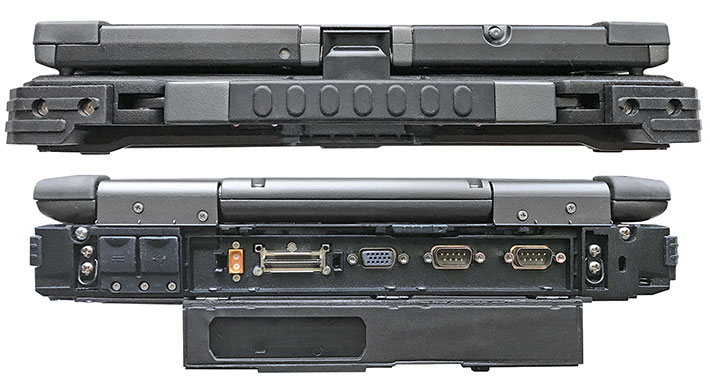
Most of the doors have metal hinges that are screwed onto the body and the actual door via two Philips screws each, making replacements very easy.
The front of the unit does not have any connectors or ports other than two small speakers to the left and right of the LCD case clasp. There wouldn't be room for anything else as most of the front is taken up the large, impressive looking magnesium handle that is screwed onto the system side of the computer. There are, however, five indicator lights built into the right side of the handle base. They show the status of power, battery, WiFi, Bluetooth and GPS.
The B300's 89-key keyboard is full-scale. It has black keys with white labels. Instead of using less legible blue for function key combos, Getac used white for those labels also, but placed them in little white square boxes. The company offers a waterproof backlit mechanical membrane keyboard and an optional waterproof backlit rubber keyboard. Here's what the two versions look like:
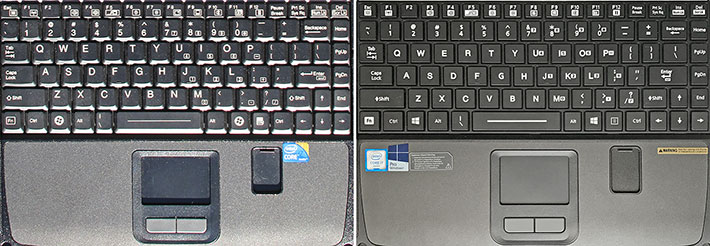
Below the keyboard is a small and slightly recessed (so you can feel its boundaries in the dark) touchpad and two mouse buttons. The touchpad is on the smallish side, but it's much more responsive than the one on its arch nemesis, the Panasonic 31 (at least that's the way it was on the last CF31 Panasonic sent us for testing). To the right is a fingerprint reader that has its own sliding door.
Both available keyboards have a red backlight that can be set to come on automatically. It's pleasant and clearly illuminates the keys in semi and full darkness. One slight distraction is that when viewed from an angle, the red illumination peeking out between keys can overwhelm the actual illumination of the key.

Above the keyboard are five hardware pushbuttons. From left to right, they are:
- Power
- P1 function button (turned display on and off on our unit)
- ECO button for engaging power conservation mode under battery power
- High-Bright button (turns display to full 1,400 nit power)
- Light sensor (engages light sensor adjustment of display brightness)

Having hardware buttons to turn quickly off the display and make it super-bright comes in very handy. It's much quicker than fumbling with menus. On the other hand, we wish the power button were elsewhere, as we often inadvertently pushed it, sending the unit to sleep.
Performance
We do not envy the product planners and engineers who must decide what level of performance to bestow upon a rugged notebook. While high performance is always good, it means either a larger battery or less battery life, and it means more heat, which may make a fan necessary. Lower performance means longer battery life and less heat, but then the machine may be considered to be too slow. The challenge then becomes to find a happy medium and balance between performance, size, weight, battery life and heat generation. Then add to that the fact that Intel has been releasing new chips and chip families at a furious pace, thus quickly obsoleting anything running on its older chips.
|
Getac B300 Generations
|
|
Generation
|
1st
|
2nd
|
3rd
|
4th
|
5th
|
6th
|
|
Year
|
2008
|
2010
|
2011
|
2012
|
2013
|
2016
|
|
Top CPU
|
Core 2 Duo
|
Core i7 1st gen
|
Core i7 2nd gen
|
Core i7 3rd gen
|
Core i7 4th gen
|
Core i7 6th gen
|
|
CPU speed
|
1.6GHz
|
2.0/2.8GHz
|
2.3/3.2GHz
|
2.9/3.6GHz
|
2.9/3.6GHz
|
2.6/3.4GHz
|
|
CPU TDP
|
17w
|
25w
|
25w
|
35w
|
37w
|
15w
|
|
Graphics
|
GM965
|
GMA HD
|
HD3000
|
HD4000
|
HD4600
|
HD520
|
|
RAM
|
0.5/4GB DDR2
|
2/8GB DDR3
|
2/8GB DDR3
|
2/8GB DDR3
|
2/8GB DDR3
|
4/16GB DDR4
|
|
Std. HD
|
80GB
|
250GB
|
250GB
|
500GB
|
500GB
|
500GB
|
|
Opt. SSD
|
NA
|
80/160GB
|
80/160GB
|
128/256GB
|
128/256GB
|
128/512TB
|
|
LCD nits
|
500/1200
|
700/1400
|
700/1400
|
700/1400
|
700/1400
|
700/1400
|
|
Battery life
|
up to 12 hrs
|
up to 11 hrs
|
up to 13 hrs
|
up to 15 hrs
|
up to 15 hrs
|
up to 15/30 hrs
|
|
Op. temp
|
32 to 131F
|
-4 to 140F
|
-4 to 140F
|
-20 to 140F
|
-20 to 140F
|
-20 to 140F
|
The table to the right shows how consistently Getac has been updating the B300 since its initial introduction. The design stays the same to guarantee complete compatibility with all peripherals and accessories, but the technology is continually updated. Makes sense.
For the latest B300, Getac not only switched from the 4th directly to the 6th generation of Intel's Core processors, but also moved from standard voltage CPUs with a high 37 watt thermal design power to much more power-efficient ultra-low voltage processors. And Getac no longer offers a low end Core i3 processor option as those lack certain Intel technologies and popular features such as Intel's "turbo" mode.
|
Available CPUs in the B300 G6
|
Intel Core i7
|
Intel Core i7
|
Intel Core i5
|
Intel Core i5
|
|
Model
|
6600U
|
6500U
|
6300U
|
6200U
|
|
Cores/Threads
|
2/4
|
2/4
|
2/4
|
2/4
|
|
Base Clock Speed
|
2.60 GHz
|
2.50 GHz
|
2.40 GHz
|
2.30 GHz
|
|
Turbo Speed
|
3.40 GHz
|
3.10 GHz
|
3.00 GHz
|
2.80 GHz
|
|
Thermal Design Power (TDP)
|
15 watts
|
15 watts
|
15 watts
|
15 watts
|
|
Smart Cache
|
4MB
|
4MB
|
3MB
|
3MB
|
|
Integrated graphics
|
HD Graphics 520
|
HD Graphics 520
|
HD Graphics 520
|
HD Graphics 520
|
|
Graphics base speed
|
300 MHz
|
300 MHz
|
300 MHz
|
300 MHz
|
|
Graphics max speed
|
1.05 GHz
|
1.05 GHz
|
1.00 GHz
|
1.00 GHz
|
|
Intel Stable Image Platform Program
|
Yes
|
No
|
No
|
No
|
|
Intel TSX-NI
|
Yes
|
No
|
Yes
|
No
|
|
Intel Trusted Execution
|
Yes
|
No
|
Yes
|
No
|
|
Intel vPro
|
Yes
|
No
|
Yes
|
No
|
Instead, the top processor option is the Intel Core i7-6600U, with the also available Core i7-6500U just a bit slower, but without certain integrated Intel technologies that some customers may need. Getac also offers the mid-range Core i5-6200U and Core i5-6300U, which also differ in speed and certain Intel technologies. To view the full spec table for these four dual-core CPUs, see here.
What is interesting here is that all available processors are of the "ultra-low voltage" variety, as compared to the "standard voltage" processors of the prior generation B300. All of them have a TDP (Thermal Design Power) of 15 watts, as opposed to as much as 37 watts of the chips in older B300 versions. "Thermal Design Power" is an Intel standard that describes how much heat a system must be able to remove when using a certain processor. Obviously, the heat generated by 37 watts requires much more cooling than that by 15 watts. Back in the day, TDP was a good measure of performance as well, but today's CPUs can do more with less.
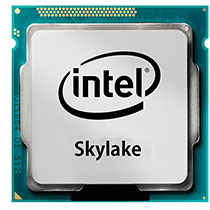 See what that means? Getac switched to ultra-low voltage processors that use less energy but, thanks to their advanced technology, provide the same or better performance than the older higher-wattage chips. Less energy means you don't need the same big battery, or you get longer life out of a charge if you keep the same battery. Getac banks on these new processors being so efficient that they provide the same or better performance than the older chips, which means the B300 gets even better battery life from the same size battery. It's like using am energy-efficient, high-tech 4-cylinder turbocharged motor instead of an old, low-tech V8 gas guzzler. See what that means? Getac switched to ultra-low voltage processors that use less energy but, thanks to their advanced technology, provide the same or better performance than the older higher-wattage chips. Less energy means you don't need the same big battery, or you get longer life out of a charge if you keep the same battery. Getac banks on these new processors being so efficient that they provide the same or better performance than the older chips, which means the B300 gets even better battery life from the same size battery. It's like using am energy-efficient, high-tech 4-cylinder turbocharged motor instead of an old, low-tech V8 gas guzzler.
Here's a brief explanation of Intel technologies that the i7-6600U and i5-6300U have, but the i7-6500U and i5-6200U do not:
- vPro provides extra security and management capabilities that are required in many enterprise deployments (see Wiki Intel vPro).
- TSX-NI Transactional Synchronization Extensions New Instructions) helps make parallel operations more efficient via improved control of locks in software (see Wiki TSX).
- SIPP (Stable Image Platform Program) allows deployment of standardized, stable image PC platforms for at least 15 months (see Intel SIPP), and
- Trusted Execution technology provides security capabilities such as measured launch and protected execution, and may thus also be an enterprise requirement (see Wiki Trusted Execution Technology).
- Skylake also brings Intel Authenticate, Intel's new enhanced hardware security that strengthens identity protection.
In addition, the 6th gen Intel Skylake-based Getac B300 benefits from a switch to more efficient and faster DDR4 RAM, as well as the latest and more efficient Intel WiFi (8260ac) and Bluetooth (BT 4.2) versions. For connectivity, there are now three ultra-fast USB 3.0 ports, two legacy RS232 serial ports, both VGA and HDMI video, audio, Gigabit LAN, and a docking port. The legacy RJ11 modem port is gone.
In order to get a sense of how this latest Getac B300 performs compares to earlier generation B300s we tested in our lab, we installed Passmark Software's PerformanceTest 6.1 that runs about 30 tests covering CPU, 2D graphics, 3D graphics, memory, and disk and then computes scores for each category and an overall PassMark score. We also installed the CrystalMark benchmark suite that tests various subsystems and then provides an overall score. The results are below.
|
Getac B300 Benchmarks and Comparisons (PassMark 6.1)
|
|
PERFORMANCE COMPARISON
|
Getac
|
Getac
|
Getac
|
Getac
|
|
Model
|
B300 G6 (2017)
|
B300 G3 (2012)
|
B300 G2 (2011)
|
B300 G1 (2010)
|
|
Processor Type: Intel
|
Core i7
|
Core i7
|
Core i7
|
Core 2 Duo
|
|
Processor Model
|
6500U
|
2649M
|
620LM
|
L7500
|
|
CPU Speed
|
2.50GHz
|
2.30GHz
|
2.00GHz
|
1.60GHz
|
|
Turbo Speed
|
3.10GHz
|
3.20GHz
|
2.80GHz
|
NA
|
|
Thermal Design Power (TDP)
|
15 watts
|
25 watts
|
25 watts
|
17 watts
|
|
BatteryMon min draw
|
6.3 watts
|
7.5 watts
|
8.9 watts
|
NA
|
|
PassMark: CPU
|
4,577.3
|
2,026.2
|
926.6
|
983.9
|
|
PassMark: 2D Graphics
|
490.2
|
373.6
|
258.3
|
158.5
|
|
PassMark: Memory
|
1,335.3
|
777.2
|
629.5
|
400.0
|
|
PassMark: Disk
|
2,916.0
|
1,480.6
|
26,187
|
14,320
|
|
PassMark: 3D Graphics
|
564.6
|
164.1
|
272.7
|
138.3
|
|
Overall PassMark
|
2,195.8
|
1,057.8
|
805.6
|
420.8
|
|
ALU
|
48,741
|
41,711
|
26,187
|
14,320
|
|
FPU
|
51,552
|
41,151
|
25,170
|
16,990
|
|
MEM
|
58,244
|
19,969
|
21,810
|
10,148
|
|
HDD
|
33,772
|
26,096
|
8,668
|
6,711
|
|
GDI
|
17,007
|
12,452
|
8,560
|
2,565
|
|
D2D
|
6,194
|
2,388
|
1,819
|
4,535
|
|
OGL
|
15246
|
3,425
|
2,208
|
1,010
|
|
Overall CrystalMark
|
230,756
|
147,192
|
94,422
|
56,289
|
The numbers very much speak for themselves. Without forcing its customers to abandon their investment in B300 docking, peripherals and accessories going back almost a decade, Getac has managed to more than quadruple performance from the original design. And that's without adding a fan, without putting in a much bigger battery, and without needing to change the basic, mature and field-proven platform.
One could now argue that a decade's worth of rapidly advancing technology would easily allow a thinner, lighter wide-screen form factor, and that's undoubtedly so, and will be so at some point in the future. But for now, it's fair to say that the B300's original designers future-proofed this platform beyond any expectation.
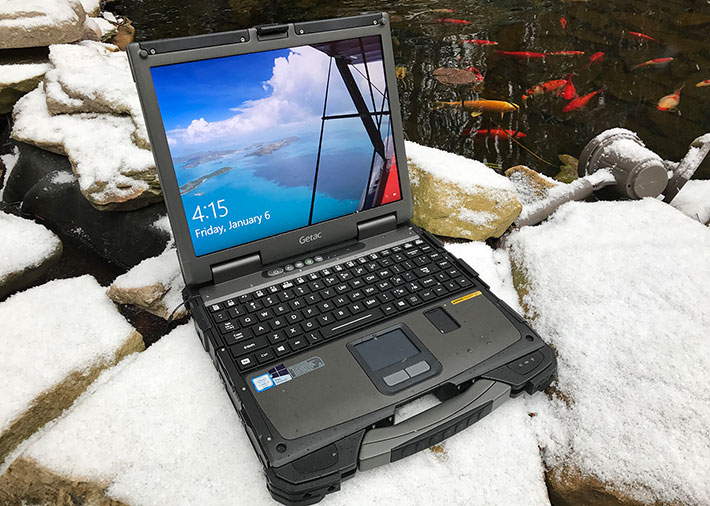
Power draw and battery life
What does all of this very significant performance mean for the latest B300's battery life? The competition has set the bar very high in this class, with Panasonic claiming 18 hours from the main battery and a combined 27 hours with their optional media bay secondary battery. The last Dell 14 Rugged Extreme we tested clocked in at almost 15 hours. Looking at our testing archive, we found that the original B300 managed to reach a theoretical maximum battery life of almost 12 hours, and a 3rd generation i7-equipped B300 benchmarked a theoretical maximum battery life of 8 to 10 hours in 2011.
 As is our standard procedure, we used Passmark Software's BatteryMon power management benchmark utility to measure the B300's power draw under various operating conditions. As is our standard procedure, we used Passmark Software's BatteryMon power management benchmark utility to measure the B300's power draw under various operating conditions.
First we set the Windows 10 power options to "Balanced" and display brightness to its lowest setting (0%). That way we saw an idle power draw of 6.4 watts. We then cranked the backlight up to 50%, and draw increased to 7.6 watts. Then we cranked brightness all the way up to 100% and saw 8.9 watts.
Next we set the Windows 10 power options to "Power Saver" and display brightness at its lowest setting (0%). That way we saw an idle power draw of 6.3 watts. We then cranked the backlight up to 50% and draw increased to 7.2 watts. Then we cranked brightness all the way up to 100% and saw 8.0 watts.
|
Getac B300 Power Draws (at idle)
|
|
Backlight level
|
Lowest (0%)
|
50%
|
Maximum (100%)
|
|
Power Saver
|
6.3 watts
|
7.2 watts
|
8.0 watts
|
|
Balanced
|
6.4 watts
|
7.6 watts
|
8.9 watts
|
|
Max Performance
|
6.9 watts
|
8.2 watts
|
9.4/21.3 watts
|
Finally, we set the tablet to "Max Performance." At the lowest brightness we saw an idle power draw of 6.9 watts. At 50% brightness draw increased to 8.2 watts. And at the maximum standard brightness setting, electric draw reached 9.4 watts. Turning on the superbright backlight via push button, draw rose to 21.3 watts
What do those power draw figures mean in terms of projected battery life? The beefy Li-Ion battery of the B300 has a capacity of 96 watt-hours. Dividing that by the 6.3 watt minimum observed draw would indicate 15.3 hours of battery life with the system staying awake the whole time. That's just as Getac claims. In the maximum performance settings and with the superbright 1,400 nits backlight booster, theoretical battery life would drop to 4.5 hours.
As always, real world mileage will vary. Minimum draw in a test lab is not an accurate predictor of actual battery life. However, it appears that the power management of the 6th generation "Skylake" Intel Core chips works very well indeed. Combine that with Windows 10's good power management and Getac's own extensive power management settings, and this latest B300 is more power-efficient than its predecessors despite vastly increased performance. Getac's claim of 15 hours seems possible, and twice that via an optional second battery that goes into the media bay en lieu of the optical drive. Do keep in mind, though, that power settings do affect clock speed.
Getac G-Panel
The Getac B300 comes with an updated version of the Getac G-Panel that combines a number of special utilities and helper apps that make using the unit quicker and simpler than going to the standard Windows control panels, which can be a cumbersome process.
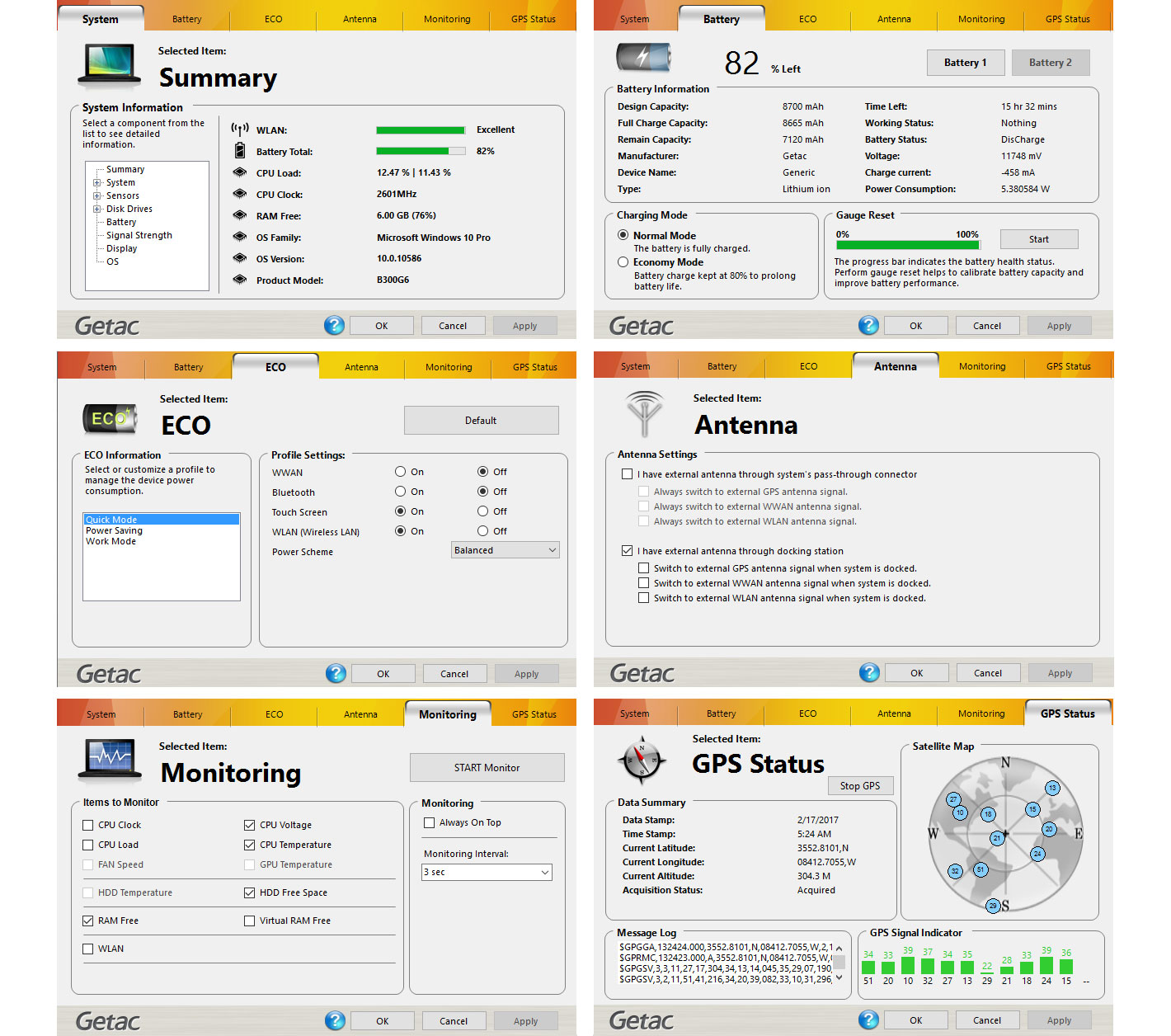
And here is what the G-Panel provides:
- Summary provides a one-look summary of all major data, including battery status, CPU load and clock speed, wireless LAN signal strength, free RAM and so on. You can also drill down for more detailed and technical data.
- Battery shows % left in a large numeral, plus just about any other battery statistic you may want. It also shows the current power consumption. With the backlight at its lowest and all power savings measures engaged, the reading was as low as 5.4 watts!.
- ECO displays and controls power savings settings. You can customize the settings and even have certain features such as Bluetooth, WiFi or the touch screen turned off.
- Antenna is where external antenna settings via pass-through connector or via docking station are configured. GPS, WLAN and WWAN can all be separately configured.
- Monitoring lets you graphically view about a dozen parameters such as CPU clock, load, voltage, temperature; free RAM, LAN stats, etc. They pop up in their own windows, and the only additional wish I'd have is being able to set the graph upper and lower limits.
- GPS Status shows satellites and summary GPS data.
Note that Getac has a variety of additional G-Panel modules that cover areas such as sensors, vehicle ignition, etc.
QuadraClear display technology
Most rugged notebooks will be used outdoors and sometimes in bright, direct sunlight. Standard transmissive LCD displays, however, wash out in daylight, and that's why over the past decade or so, sunlight-readability has become a major selling point in the rugged notebook sector.
Rugged computer manufacturers have long been in a race for the best possible outdoor/sunlight-viewable display technology. Getac generally calls theirs "QuadraClear" (see QuadraClear page). 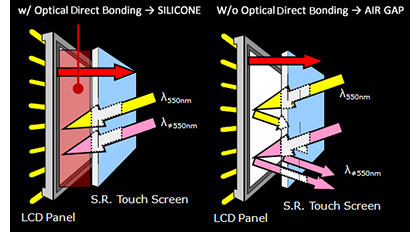 The term derives from its four core features: a bright backlight, anti-reflective coatings, linear polarizer, and circular polarizer. The term derives from its four core features: a bright backlight, anti-reflective coatings, linear polarizer, and circular polarizer.
All major manufacturers of outdoor-usable mobile computing equipment use those technologies, and so the difference boils down to a) backlight brightness and b) the extent to which the expensive optical coatings are applied and how the various layers are bonded (the fewer reflective surfaces, the better). Getac calls their layer bonding process "LumiBond" (see LumiBond page).
All else being roughly equal, display backlight power then determines the all-important effective contrast ratio which then translates into the degree of real world outdoor readability.
And backlight strength is what sets the B300 apart. A standard notebook backlight is in the 170 to 200 nits luminance range (1 nit = 1 candela per square meter) range. Some manufacturers up the brightness in their rugged products, usually into the 300-400 nits range. Getac offered the original B300 with 500 nits, but beat everyone with an optional superbright 1,200 nits backlight. In later generations, including this latest one, they upped the ante with an optional industry-leading 1,400 nits backlight.
The super-bright 1,400 nits LED light is considerably brighter than the maximum of the standard brightness range. To engage it you push a special button above the keyboard. Turn it on and the screen lights up with an intensity unseen in any regular display. Having that hardware button is also the key to keeping power draw in check: when you need the superbright backlight, switch it on. When you don't need it anymore, turn it off. That's much easier with a button than via menus and software sliders.
How does it all work in real life? Very well. The pictures below show different scenario comparisons between the B300 and a 12.9-inch Apple iPad Pro. The iPad Pro has an excellent display with a maximum brightness of about 430 nits.
The first comparison picture below shows the two machines outdoors on a bright morning. On the left side, both devices have their screen brightness set to maximum. Both are quite bright, but you can already see one of the B300 display's big advantages: no reflections. The B300 screen has a semi-matte surface and probably a degree of anti-glare treatment. As a result, there are no reflections whereas the iPad Pro's glossy screen almost looks like a mirror.
The right side shows the very same comparison, but now with the B300's super-bright 1,400 nit backlight button pushed. The difference is tremendous.
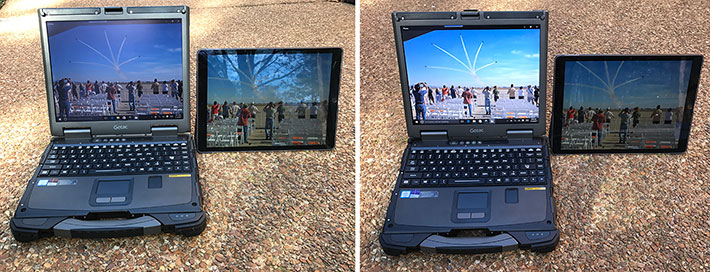
Below are the two machines in broad daylight and facing the sky. Since the sky was clear, reflections weren't much of an issue for the iPad Pro. Turning the B300's backlight boost button on again makes a big difference. Not quite as big as in the picture above, which was taken in a darker spot, but still very noticeable.
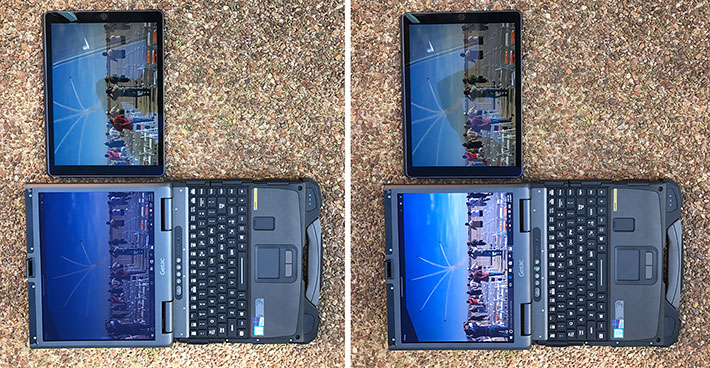
The toughest test sunlight-viewable displays must pass is when they directly face the sun. In the picture below, the B300 is in direct sunlight (you can see if by the stark shadow of the photographer). On the left, backlight is up to the maximum normal level. The display remains marginally readable, but is on the verge of washing out. This is where a lot of other notebooks claiming outdoor viewability become useless. With the B300, you simply push the high-bright button for a much brighter, clearer picture.
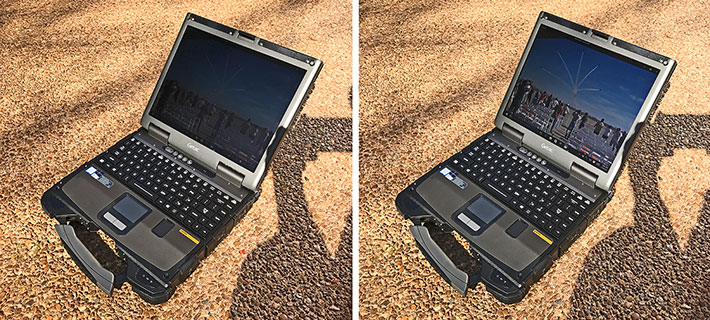
Overall, the superbright setting accessible via button push is a great idea that makes the B300 usable in situations where lesser displays wash out. Yes, it takes a lot of power to operate the display at full brightness, but that's what the on-off button is for.
A couple other comments about the display. You can adjust the backlight in 16 steps via keyboard brightness buttons, and via 64 steps in the Windows control panel. However, being able to totally turn off the backlight via a single button, and turning it to super-bright also via a single button is extremely useful.
In our reviews of earlier generations of the B300, we hoped for improvement is in their display viewing angles. We don't know what changed, but the viewing angle issue seems to have been resolved in this latest generation.
Wireless and expansion
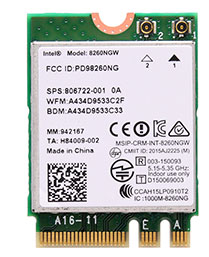 As is, the Getac B300 comes with an Intel Dual Band Wireless-AC 8260 that provides 802.11ac WiFi and dual-mode Bluetooth Version 4.2. 802.11ac is three times faster than 802.11n. And Bluetooth 4.2 can offer significantly faster data transfer due to longer packet size, is more secure, and allows interfacing with the latest low-energy Blue Tooth devices. As is, the Getac B300 comes with an Intel Dual Band Wireless-AC 8260 that provides 802.11ac WiFi and dual-mode Bluetooth Version 4.2. 802.11ac is three times faster than 802.11n. And Bluetooth 4.2 can offer significantly faster data transfer due to longer packet size, is more secure, and allows interfacing with the latest low-energy Blue Tooth devices.
An integrated SiRFstarIV GPS receiver is optionally available, and for Wide Area Network communication, there is an optional 4G LTE multi-carrier mobile broadband (XLTE ready).
As far as expansion goes, there is one PC Card Type II slot and one ExpressCard 34/54 slot. There are a number of options here as you can also opt for two adjacent PC Card Type II slots (or one Type III), or a PC Card slot and a Smart Card reader. There is also an SD reader that was able to read our 32GB cards and thus apparently is of the SDHC variety.
Additional expansion is possible via the B300's Media Bay. It is located on the left side of the computer. Our unit came with the Sony Optiarc rewritable drive. Depending on needs and applications, that can be replaced either with an optional second battery or an optional second hard drive.
Security
Security is becoming ever more important, and Getac upped the security ante in this latest version of the B300 with a TPM 2.0 module, strong multifactor authentication, and full support for Windows 10 security features to help protect against known and emerging threats.
BitLocker hard drive encryption protects data at rest, in use and in transit. Microsoft Passport and Credential Guard provide additional protection. Credential Guard uses virtualization-based security to isolate certain data so that only privileged system software can access them. In the event that the system is ever stolen, optional Absolute DDS allows it to be disabled remotely. There's also a slot for the simple but effective Kensington lock, and customers can specify either a fingerprint reader or Smart Card reader.
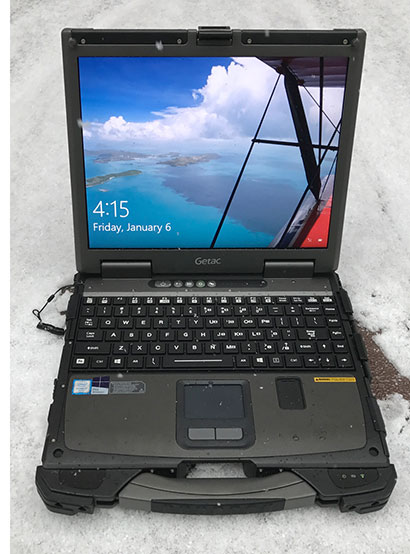 Our test system also came with fingerprint registration software that works with the B300's fingerprint scanner. Our test system also came with fingerprint registration software that works with the B300's fingerprint scanner.
All of this can get pretty involved. Some users may never implement TPM, fingerprint scanning or even passwords, whereas others may be set up in accordance with their company's IT security procedures, or they may configure an individual system for maximum security.
Over all this, don't forget physical security and get a Kensington locking cable to use with the Kensington slot on the backside of the unit. It is inexpensive insurance against theft.
Touchscreen
Our B300 came with the optional resistive touch screen that can be operated either with a supplied small telescopic stylus that sits in its own garage at the upper left of the keyboard, or with a finger.
The touch screen can be calibrated using 4, 9, or 25 points, the doubleclick area can be adjusted, and it can be set to mouse or digitizer mode. There is less functionality, though, in this utility compared to that of the original B300 that also let you map the display so that only part responded to touch, a useful feature for custom applications.
With both Windows 7 and Windows 10, the B300 has inherent access to a wealth of pen and touch functionality. You can use just about any software designed for use with a pen, though keep in mind that resistive touch does not sense the pen floating above the display like an active digitizer does. And there's none of the effortless tapping, pinching and panning as in capacitive multi-touch.
Ruggedness
The Getac B300 is a rugged computer capable of absorbing rough handling and demanding environmental conditions. The magnesium-alloy housing with its protective rubber bumpers on all four corners on top, large rubber bumpers at the bottom front and smaller bumpers at the bottom rear protect the unit from casual damage. The thick (and easily replaceable) bumpers on top not only provide excellent impact protection, but also keep the machine from getting scratched.
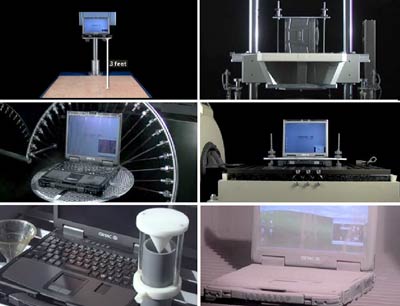 As for environmental specs, the B300 has an operating temperature range of -4 to 140 degrees Fahrenheit, making it suitable for use in virtually any operating environment from freezers to desert. As for environmental specs, the B300 has an operating temperature range of -4 to 140 degrees Fahrenheit, making it suitable for use in virtually any operating environment from freezers to desert.
In terms of listed ruggedness testing results, Getac's web documentation on the B300 is sparse, only stating that the unit is MIL-STD 810G and IP65 compliant, and can be ordered with optional compliance for UL1604 Class 1 Div. 2 (Groups A-D), salt fog exposure, MIL-STD 461F (electromagnetic interference) and MIL-STD 3009 Night Vision.
The pictures on the right are screen snaps from Getac's ruggedness demonstration videos. While the videos are impressive and real, we would like to see more detailed specs listed, and the supporting documentation available on the website.
As far as sealing goes, the Getac B300 carries an IP65 rating (as opposed to the original version's IP54). The "6" here means that the unit is now totally protected against dust, with no amount allowed; and the "5" means that it is protected against low pressure water jets from all directions, and not just water spray. Limited ingress permitted, though.
We still have some reservations about the port sealing technology, which depends entirely on exterior protective doors. There is no additional sealing that keeps dust and moisture out should the seal of a protective door fail, or the user forget to properly close and secure a door. Sealing all I/O openings in the housing with silicone glue or similar would provide a second barrier. We also feel that the various types of locks and levers used should be re-examined for smoother operation and tighter fit.
Bottom line: Leapfrogging the competition
The B300, Getac's full-size, fully-rugged notebook computer, has always been a unique machine that offered a combination of balanced and optimized features that are usually not available in any one unit. That hasn't changed. Design, construction and dimensions haven't changed. This latest generation B300 works with any earlier dock or accessory. But Intel 6th generation Core processors now provide more performance, even longer battery life, and substantially more powerful integrated graphics in a thoroughly field-proven design with exceptional ruggedness, security and outdoor viewability.
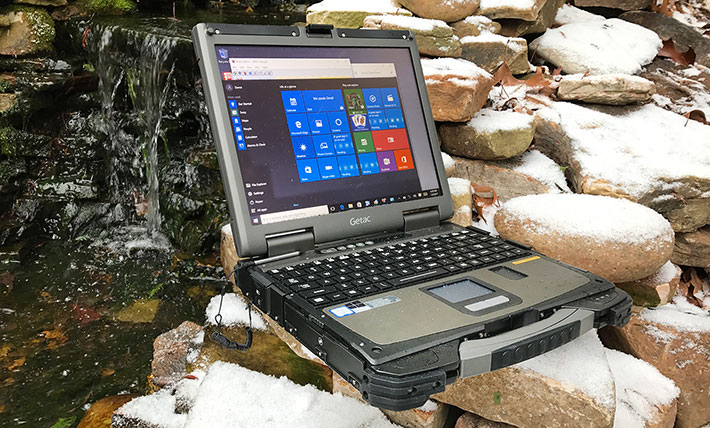
Amazingly, even with a high-end Intel "Skylake" Core i7-6600U processor, the B300 still does not need a fan. It runs in complete silence, and, thanks to an elaborate heat piping system, hardly warms up at all. Other beneficial technology updates include much faster DDR4 RAM, faster graphics as part of the new Intel chips, more and faster storage, updated WiFi and Bluetooth, and all three USB ports are now of the much faster USB 3.0 variety.
Despite the significant performance improvements, battery life is actually even better than that of the predecessor machine. We saw as much as 15 hours. Battery life will be less under heavy use, but it's better than before even with much improved performance. There's a media bay that can accommodate a second battery of equal capacity, boosting potential battery life up to an incredible 30 hours. Ruggedness is exceptional with a very wide operating temperature range, IP65 sealing, and adherence to numerous military standards.
A stunning feature of the B300 is the pushbutton-activated incredibly strong backlight of its optional 1,400 nits 13.3-inch display. In everyday use it's a standard transmissive LCD with some coatings that provide an excellent degree of outdoor viewability. But switch on the super-intense 1,400 nits backlight and the display is brighter than any other we've seen.
Overall, from a competitive standpoint, with this latest B300, Getac leapfrogs Panasonic's Toughbook 31 in technology, security and battery life.
-- Conrad H. Blickenstorfer, February 2017
Getac B300 2017 Specs:
| Type |
Rugged notebook
|
| Introduced |
Added 06/2016, full review 02/2017
|
| Processor |
Intel Core i7-6600U (2.6/3.4GHz), 4MB SmartCache
Intel Core i7-6500U (2.5/3.1GHz), 4MB SmartCache
Intel Core i5-6300U (2.4/3.0GHz), 3MB SmartCache
Intel Core i5-6200U (2.3/2.8GHz), 3MB SmartCache
|
| Thermal Design Power |
All 25 watts
|
| Graphics |
Intel HD Graphics 520
|
| OS |
Windows 10 Professional, Windows 7 Professional
|
| Memory |
4GB DDR4 2133MHz, expandable to 16GB |
| Display |
13.3-inch/1024 x 768 pixel sunlight-readable TFT with 700 nits backlight. Optional: 1400 nits sunlight-readable "QuadraClear" display with optional night vision feature |
| Digitizer |
Resistive touch screen (opt.) |
| Keyboard |
Waterproof backlit mechanical membrane keyboard; optional waterproof backlit rubber keyboard |
| Storage |
Shock-protected removable SATA 500GB or optional solid state drives up to 1TB
|
| Expansion slots |
1 x PC Card Type II, 1 x Express Card/54mm (or Smart Card reader), 1 x SD Card
|
| Housing |
Magnesium alloy, sealed ports |
| Size |
11.9 x 10.35 x 2.36 inches (304 x 263 x 60 mm) |
| Weight |
Starting at 7.7 lbs; 8.75 lbs. as tested, with battery, handle and optical drive
|
| Operating temperature |
-20° to 140°F (-29° to 60°C)
|
| Ingress protection |
IP65 (totally dustproof, can handle low pressure water jets from all directions) |
| Drop/shock/other |
MIL-STD-810G |
| EMI |
MIL-STD-461F |
| Salt fog |
optional salt fog compliance |
| Power |
Li-Ion (11.1V, 8,700mAh, 96 watt-hours); optional media bay battery (8,700mAh) ("up to 15/30 hours") |
| Interface |
3 x USB 3.0, 2 x RJ11, 1 x gigabit RJ45 LAN, 2 x Serial RS232, dock, audio in/out, 1 x VGA, 1 x HDMI, fingerprint scanner, opt. RF antenna pass-through
|
| Wireless options |
Intel Dual Band Wireless-AC 8260 802.11ac, Bluetooth 4.2; optional SiRFstarIV GPS, optional 4G LTE multi-carrier mobile broadband (XLTE ready)
|
| Price |
Inquire |
| Contact |
GETAC us.getac.com |
| Warranty |
5-year bumper-to-bumper standard |
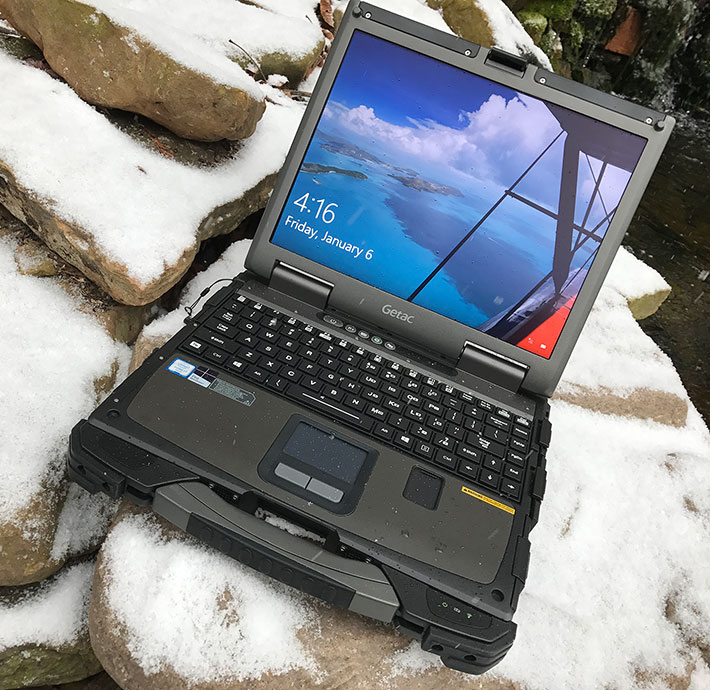
(copyright 2017 RuggedPCReview.com)
|












